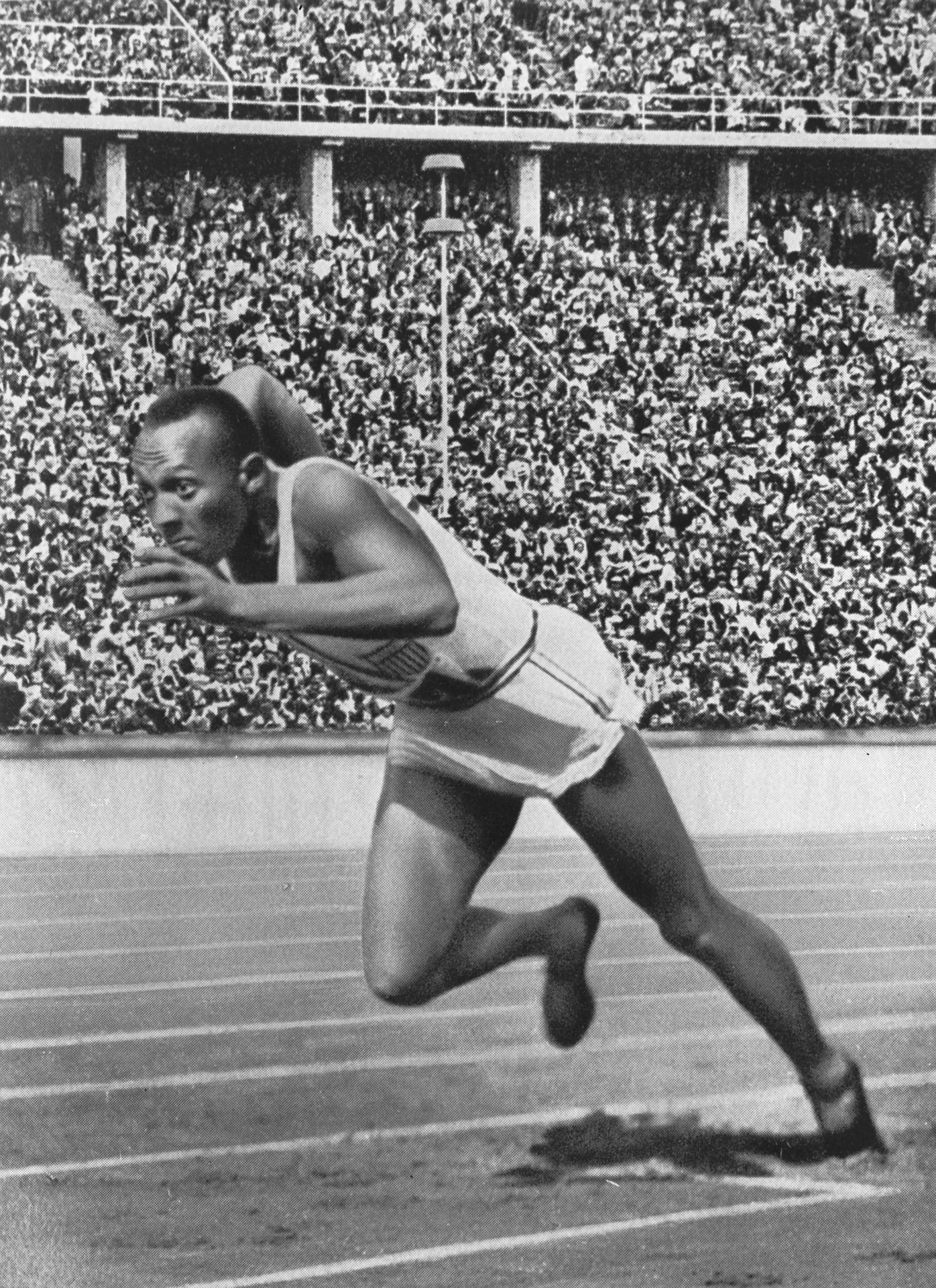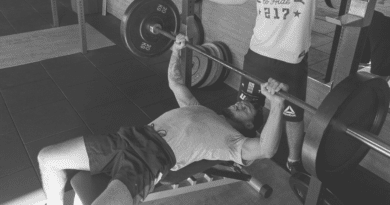Olympic Games History – The Incredible Story of Jesse Owens
Learn more about the story of Jesse Owens, one of the greatest members of the Athletic hall of fame.
On February 4th, a baby girl was born in Tuskegee near Montgomery. On September 12th, a baby boy was born in Oakville near Decatur.
The year was 1913, Stalin and Hitler were living in Vienna, suffragette Emily Davison would throw herself under George V’s horse in the Epsom Derby and Jack Johnson, the world’s first Black heavyweight boxing champion, was the most famous man in America.
The births took place in the heart of Dixie, the old Confederacy, in the Cotton state of Alabama. Both children would grow up to become internationally famous.
Rosa’s refusal to vacate her seat to a white passenger led to the Montgomery bus boycott of 1955 and Rosa Parks would be revered as the “first lady of civil rights.”
Jesse Owens
James, known as J.C. by his family, would become the world’s fastest man and Jesse Owens would win 4 gold medals at the Berlin Olympic Games of 1936.

James Cleveland Owens was the youngest child of 10 children, having 6 brothers and 3 sisters, born to impoverished Baptist share-croppers with low expectations and a justified fear of white landlords.
His father’s father was a slave. Frail and skinny, J.C. suffered from bronchial problems and, at the age of 5yrs, he survived a makeshift operation when his mother cut out a tumour, which was pressing onto his chest, with a knife as J.C. bit down on a leather strap.
Severe blood loss meant his life hung in the balance for 3 days.
The family could not afford to pay for a doctor. He attended the local school-house for reading and writing, harvested cotton in the summer when well and loved to run barefoot.
He said that running gave him a sense of freedom and control. He could move in any direction under his own power.
When J.C. was 9yrs old, the family joined the Great Migration north to escape rural poverty by finding work in the Great Lakes industrial states.
Many followed Highway 61 to Chicago but his father and older brothers became steelworkers in Cleveland, Ohio on the shores of Lake Erie. J.C. attended Bolton Elementary School. When asked his name by the teacher, his pronunciation of J.C. in his Southern drawl sounded like Jesse and the new name stuck.
In 1928, at Fairmount Junior School, he set school records for the Long and High Jumps, under the tutelage of Charles Riley, his PE teacher and coach, who would become a surrogate father.
He encouraged Jesse to train before school and he extolled the benefits of running longer distances. It was here that Jesse met Minnie Ruth Solomon (b 1915) from Georgia. She was under 5 feet tall (under 152cms) and first dated Jesse when she was 13yrs, 2yrs younger than him.
A daughter, Gloria, was born in 1932, they married in 1935 and 2 more daughters joined the family, Marlene (b 1937) and Beverley (b1940).
In 1930, Jesse transferred to East Technical High School, where athletics continued to attract him. Taking fast, short strides, he ran in an upright style, that was replicated by the Texan Michael Johnson, who won Olympic gold medals at 200m and 400m at Atlanta in 1996.
In his final year, in 1933, at the National Interscholastic Championships in Chicago, he set a World Record in the 200yds (182m), equalled the WR in the 100yds (91m) and won the LJ. When he returned home to Cleveland, Jesse was honoured with a parade.
Many universities were keen to enrol to enrol the well-known, promising athlete. Jesse selected Ohio State (Columbus), which allowed to work part-time as a freight elevator operator.
The USA was struggling in the midst of the Great Economic Depression, precipitated by the Wall Street Crash of 1929. Earlier in 1933, FDR had introduced his New Deal to refloat the economy by promoting public works. Money was very tight for blue-collar families and Jesse’s father had been injured in a traffic accident.
Jesse was coached at OSU by Larry Snyder, who improved his slow starts by putting him into a tight crouch and by encouraging him to cycle his legs during the flight phase of the LJ.
Yet Jesse was not allowed to board at the “whites only” dormitory, despite becoming captain of the track team.
At the Big Ten Championships (intercollegiate) held at Ann Arbour, Michigan in May 1935, 21yr old Jesse, the Buckeye Bullet, broke 5 WRs and equalled a sixth (100yds) in the space of 45 minutes despite enduring back pain from a fall downstairs that meant he couldn’t even bend to touch his knees!
In just one attempt at the LJ, he leapt 8.13m for a WR that would last for 25yrs until Ralph Boston jumped 8.21m. He jumped 8.12m at the Rome Olympics with Jesse looking on.
Jesse lowered the times in the 220yd dash (and 200m) and 220yd low hurdles and he amassed almost all the points for OSU. Michael Johnson called it, “one of the most amazing feats in any sport.”
The Berlin Olympics were supposed to take place in 1916, but WW1 scuppered that plan so when they were held in 1936 it was during the Third Reich of Nazi Germany under the gaze of Adolf Hitler not the Kaiser.
In July the Spanish Civil War broke out when General Franco rebelled against a new left-wing government. Fascist leaders, like Mussolini and Hitler, sent troops to support Franco, whilst Stalinist Soviet Union backed the Republican government.
Writers, such as Hemingway and Orwell, joined the International Brigade on the side of the Republicans.
But the Games went ahead and the XI Olympiad opened on August 1st in the new 100,000 seater Olympiastadion with 49 nations participating, although Spain did withdraw.

German Jewish athletes were barred and many Jewish athletes from other countries were left at home to avoid offending the Nazi regime.
The 1936 Olympic Games
Standing 5ft 11ins (180cms), weighing 11st 11lbs (75kgs) and wearing his new leather track shoes with extra-long spikes designed by Adi Dassler (Adidas launched in 1946), 22yr old Jesse was ready to make history.
His program began the next day with the 100m heats.
Starting blocks were not officially used by sprinters until 1937 so the athletes dug shallow foot-holes with trowels. Jesse won the final with ease in 10.3secs, ahead of Georgian Ralph Metcalfe in 10.4secs, to register his first gold medal.
The LJ proved more challenging when he fouled his first 2 qualifying jumps. His main rival, the blue-eyed, blond haired Luz Long of Germany, the European record holder, suggested that he should move his marker back to ensure a safe, legal jump.
Jesse complied and leapt 7.64m to advance to the SFs. Archie Williams from California, winner of the 400m, called Jesse “the superman of the team” but felt that he undertrained, especially for the LJ.
In the final on August 4th Jesse and Luz led the field both using a similar technique, landing on 2 feet together and diving forward, although Jesse would cycle his legs in flight.
Luz’s best effort reached 7.87m but Jesse propelled himself out to an Olympic record distance of 8.06m, only 7cms shy of his WR, to win his second gold medal. Luz congratulated him warmly. “It took a lot of courage for Luz to befriend me in front of Hitler.
Hitler must have gone crazy watching us embrace,” Jesse said later.
He corresponded with his rival until the USA entered WW2 in 1941. Luz, a lawyer in Hamburg, had joined the Wehrmacht and was killed in Sicily in 1943, defending an airfield against an Allied invasion. He had asked Jesse to contact his son after the war.
Jesse visited West Germany in 1951, kept in touch with Kai-Heinrich and, incredibly, was best man at Kai’s wedding.
August 5th signalled the arrival of the 200m final. With only 6 runners for every race, Jesse had had to qualify from the heats, QFs and SFs, but showed no sign of fatigue. With a very rapid cadence, he destroyed the field, breaking the tape in 20.7secs, an unofficial WR for a curved track.
Californian Mack Robison, whose brother was a baseball star, was adrift at 21.1secs to win the silver medal, yet he still broke the Olympic record. The third gold medal was in the bag.
The 3 heats and final of the 4x100m relay took place on the same day, August 9th. Inexperienced Jesse would run the first leg and hand over to Ralph Metcalfe, who finished behind him in the 100m.
Tiny Texan Foy Draper (5ft 5ins, 165cms; 8st 7lbs, 54kgs) would run the curve on the third leg and Frank Wykoff would bring the baton home.
Frank was part of both the American Olympic sprint relay teams that had taken the gold medals in WR times in Amsterdam (1928) and Los Angeles (1932), yet the Iowan was still only 26yrs old. 2 black runners and 2 white runners.
Controversially, the head coach 2 Jewish sprinters with Owens and Metcalfe. Jesse had protested but was informed that “you’ll do as you are told.” However, the team was clearly improved by the inclusion of the gold and silver medallists from the 100m.
The Americans scorched to a 40.0secs WR in the first heat as 15 nations were whittled down to 6 finalists. By today’s standards the exchanges were slow with the incoming runner almost pulling alongside the outgoing one.
In the final Jesse put the Americans into a lead that was never threatened. They won in another WR time of 39.8secs, that would last for 20yrs, ahead of the Italians (41.1) and the Germans (41.2). Foy Draper, like Luz Long, would become a WW2 casualty in 1943.
The twin engined attack bomber he was piloting was shot down in North Africa during the battle of the Kasserine Pass.
Jessie had won 4 Olympic gold medals at the age of 22yrs and was entitled to reckon that he could dominate world sprinting for the next 10yrs.
He attributed his success to running as if the ground was on fire. “I let my feet spend as little time on the ground as possible. From the air foot down, and from the ground foot up.”
After the Olympics the entire American track and field team was expected to compete in Sweden but Jesse objected and flew home, keen to negotiate some lucrative product endorsements.
His very poor background fostered an urge in Jesse to chase the dollar (he was prosecuted for tax evasion in 1966).
He was not invited to the White House to shake hands with the President (FDR) as other successful sportsmen had done, but he was more hurt by this snub than by the fact that Hitler had not met him.
After all, the German Chancellor only shook hands with a few medallists and Germany led the medal table (No 2 = USA) so there were lots of home grown athletes to acknowledge.
But Jesse’s world imploded when he was informed that his amateur status had been revoked for his refusal to travel to Sweden with the team. Ironically, WW2 caused the cancellation of the 1940 and 1944 Olympic Games and if Jesse had competed in the 1948 London Austerity Games, he would have been 34yrs old.
By the time Joe Louis, the Brown Bomber, defeated the Cinderella Man in 1937 to begin his 12yr reign as world heavyweight boxing champion, Jesse was reduced to running races against dogs, horses, motorcycles and cars and touring with the Harlem Globetrotters.
The horses were spooked by the crack of the starting pistol so Jesse, who was given a start, usually won. He said he felt like a freak.
He was soon forced to find regular employment saying, “you can’t eat gold medals!” He worked at a gas station, as a janitor, ran a dry-cleaning company and spent the war years in Detroit with Ford as an assistant personnel manager.
In 1949, the Owens family moved to Chicago, where Jesse ran a public relations company. The city would later become the power base for Barack Obama, America’s first Black President, and all 3 daughters, graduates of OSU, would live out their lives in the Windy City.
They said their father was quite strict and expected them to become respectful, moral members of society.
Jesse did not widely promote sport. If he could not sprint, he was not interested in jogging, but he did take up golf.
He did attend several Olympic Games as an American goodwill ambassador, and at Munich in 1972 he met Max Schmeling, the German heavyweight boxer, who lost to Joe Louis in a famous fight in 1938 that symbolised the struggle between democracy and fascism.
Jesse did organise running clinics overseas and was briefly a running instructor with the New York Mets.
1968 brought the assassination of Martin Luther King in Memphis, increasingly violent protests against the Vietnam War and the Black power salutes of Tommie Smith and John Carlos at the medal ceremony for the 200m in Mexico City. Jesse was initially unimpressed but later conceded in his memoir that Black protest was necessary to combat racial discrimination.
In 1972, he effectively retired and moved to Phoenix in Arizona to enjoy the warm, dry climate. From the age of 32yrs Jesse developed a pack-a-day cigarette habit and in December 1979 he was hospitalised with an aggressive form of lung cancer.
He died in Tucson on March 31st 1980 at the age of 66yrs. He was buried in Oak Woods cemetery in Chicago beneath the simple epitaph that read, “Jesse Owens, 1936 Olympic Champion”.
President Jimmy Carter, who Jesse had asked to boycott the 1980 Moscow Games, said in a eulogy, “Perhaps no athlete better symbolised the human struggle against tyranny and racial bigotry than Jesse Owens.” Berlin would name a street and a secondary school in his honour.
His wife Ruth, who guarded his legacy, would die in 2001 in Chicago.
Jesse Owens and Carl lewis
48yrs after Jesse’s 4 Olympic gold medal haul in Berlin, another exceptional athlete, also born in Alabama and 22yrs old when the opening ceremony was held, called Carl Lewis, equalled his achievements in the same events in Los Angeles in 1984.
He accrued a total of nine Olympic golds and won the LJ in 4 successive Games, yet Carl’s average rate of improvement is less than 5%, confirming Jesse’s brilliance.
Carl benefited from the use of starting blocks and advances in running kit, training drills and nutrition.
Olympic Winning Times and Distances:
| 1936 | Berlin | 1984 | Los Angeles | % Advance |
| Jesse Owens | Carl Lewis | |||
| 100m | 10.3secs | 100m | 9.99secs | 3% |
| 200m | 20.7secs | 200m | 19.80secs | 4.5% |
| 4x100m | 39.8secs WR | 4x100m | 37.83secs WR | 5% |
| Long Jump | 8.06m | Long Jump | 8.54m | 6% |
If you enjoyed reading about Jesse Owens, learn more about the fascinating history of the 4 minute mile.




